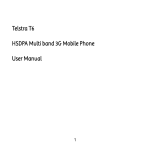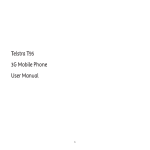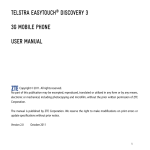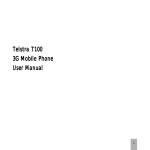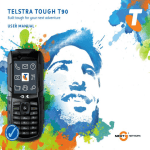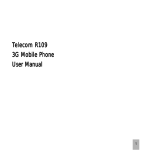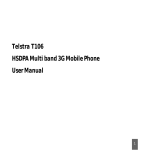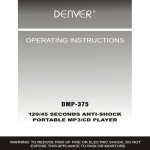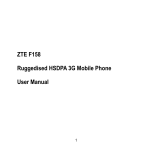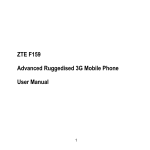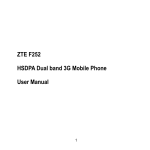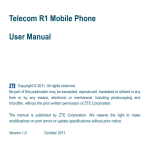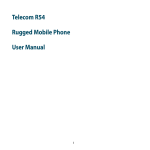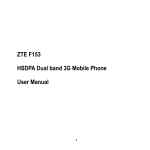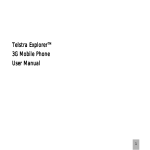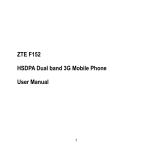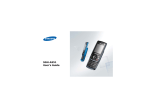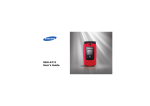Download Telstra T165i HSDPA Multi band 3G Mobile Phone User Manual
Transcript
Telstra T165i HSDPA Multi band 3G Mobile Phone User Manual 1 PC Software Requirements Join Me PC Software included supports Microsoft Vista (only 32 bit), Windows 2000 with Service Pack 4 or Windows XP with Service Pack 2 only. A limited version of Join Me is provided that supports MAC. 64 Bit systems are NOT supported. Warnings and Safety Notices Please read all the safety notices in section 1.2 and 16 before using this device. Copyright © 2008 ZTE Corporation All rights reserved. 2nd Edition November 2008 No part of this publication may be excerpted, reproduced, translated or utilized in any form or by any means, electronic or mechanical, including photocopying and microfilm, without the prior written permission of ZTE Corporation. ZTE Corporation operates a policy of continuous development. ZTE Corporation reserves the right to make changes and improvements to any of the products described in this document without prior notice. Limitation of Liability ZTE shall not be liable for any loss of profits or indirect, special, incidental or consequential damages resulting from or arising out of or in connection with using this product, whether or not ZTE had been advised, knew or should have known the possibility of such damages. The user should refer to the enclosed warranty card for full warranty and service information. 2 RF Safety Information The handset has an external antenna located at the top of the phone. For optimum performance with minimum power consumption always extend the antenna during a call and do not cover the antenna area with your hand. Hold the handset between thumb and finger in the middle of the device. Covering the antenna affects call quality, may cause the handset to operate at higher power level than needed, and may shorten talk and idle times. Radio Frequency Energy The handset is a low-power radio transmitter and receiver. When switched on it intermittently transmits radio frequency (RF) energy (radio waves). The transmit power level is optimized for best performance and automatically reduces when there is good quality reception. Maximum power is only used at the edge of network coverage so under most circumstances the power output is very low. Under poor network conditions the phone will transmit at a higher power, may get hot and will have a significantly shorter battery life. Declaration of Conformity We declare under our sole responsibility that the product(s) detailed in this manual, and in combination with our accessories, conform with the essential requirements of The Radio Communications Standard (Electro-magnetic Radiation Human Exposure) 2003 and the Australian Communications and Media Authority Section 376 of the Telecommunications Act 1997. N14945 3 1 Contents Welcome 1.1 1.2 1.3 1.4 1.5 2 17 Getting Started 2.1 2.2 2.3 2.4 2.5 2.6 2.7 3 How do I insert the USIM Card? How do I insert the Battery? How do I switch the phone On or Off? How do I connect the charger? Tips about charging and battery life How do I set the time and date? How do I lock the keypad? 4 How do I make a voice call? How do I answer an incoming call? How do I send a Text Message (SMS)? How do I navigate the Menus? 21 21 21 22 23 Contacts 4.1 4.2 4.3 4.4 4.5 4.6 17 18 19 19 20 20 20 21 Basic Operation 3.1 3.2 3.3 3.4 9 10 11 13 14 15 How to use the manual Handset Overview Keypad Functions Information Bar Icons Menu Quick Reference Guide How do I enter my Contacts? How do I copy all Contacts from a USIM card? How do I search my Contacts? How do I add a Contact from a received call number? How do I add a Contact from a received SMS (Text Message)? How do I set a dedicated ringtone or image to a Contact? 4 23 23 23 24 24 24 4.7 4.8 4.9 4.10 5 How do I set Speed Dial numbers? How do I make a call using Speed Dial? How do I update an existing Contact? Advanced Contact Options 27 Calls 5.1 5.2 5.3 5.4 5.5 5.6 5.7 5.8 5.9 5.10 5.11 5.12 5.13 5.14 5.15 5.16 5.17 6 How do I make a Voice Call? How do I make a Voice Call from my Contacts? How do I view and make a Voice Call from my Call History? Call options during an active Voice Call How do I activate Speakerphone? How do I answer a Call? How do I make a Video Call? Call options during an active Video Call How do I answer a Video Call? How do I make Emergency Calls? Videophone Setting Call Divert Call Waiting Call Barring Send my number Missed Calls Alert Call Options when Connected to a Bluetooth device 27 27 27 28 28 29 29 30 30 31 32 32 32 33 33 34 34 35 Messages and Emails 6.1 6.2 6.3 6.4 25 25 25 26 How do I send a Text Message (SMS)? How do I view a received Text Message (SMS)? How do I use Predictive Text? How do I add words to the built in Dictionary (My Words)? 5 35 35 36 37 6.5 6.6 6.7 6.8 6.9 6.10 6.11 6.12 6.13 7 Special Characters and SMS Message Length How do I send a Multimedia Message (MMS)? How do I receive a Multimedia Message (MMS)? MMS Settings WAP Push Messages How do I send an Email? How do I receive an Email? How do I set up automatic Email Retrieval? Pushmail Settings 41 How to Personalise the Phone 7.1 7.2 7.3 7.4 7.5 7.6 7.7 7.8 7.9 7.10 7.11 7.12 7.13 7.14 8 Change the Profiles Change the Shortcut Keys (Arrow keys) Change the Background Screen (Wallpaper) Change the default Ringtones Enable Vibrate Mode Engage Meeting Mode with a single key press Switch the Keytones off Change the Screen Brightness Change the Display Backlighting Set the Keypad backlighting Add a Greeting and Owner name What is the PIN Code? What is the Handset Code? Additional notes on PIN Codes 41 42 42 43 43 43 43 44 44 44 44 45 45 45 46 File Manager and External Memory 8.1 8.2 37 38 38 38 39 39 40 40 40 File Manager Installing Additional Memory - microSD card 6 46 47 8.3 8.4 9 Access the T-Flash card (microSD) using File Manager File Manager and T-Flash Options Table 10 Set Alarms Set Appointments using the Calendar 12 13 51 52 53 How to use the Camera How to use the Video Camera Viewing pictures and videos 54 Music 11.1 11.2 11.3 FM Radio Browse and play music files from File Manager Create a new Playlist 54 54 55 56 57 Assisted-GPS Connectivity 13.1 13.2 13.3 13.4 13.5 13.6 13.7 13.8 13.9 13.10 13.11 13.12 49 50 51 Imaging - Pictures and Videos 10.1 10.2 10.3 11 49 Alarms and Appointments 9.1 9.2 48 48 Use Join Me to connect the phone to a computer Installing Join Me Use Join Me to copy photos to your computer Use Join Me to transfer music from a computer Enter Contacts using Join Me Copy Contacts from the phone to the computer Import Contacts from Microsoft Outlook Import Calendar events from Microsoft Outlook Use Join Me to connect to the Internet Connect to a Bluetooth Device Dial Up Networking using USB or Bluetooth PC Connection 7 57 58 59 61 63 64 65 66 66 67 69 71 13.13 14 14.1 14.2 14.3 14.4 14.5 14.6 14.7 14.8 14.9 14.10 14.11 14.12 14.13 14.14 14.15 14.16 14.17 15 71 72 72 73 73 73 74 74 74 75 75 75 75 76 76 76 77 77 78 Browser Stopwatch Calculator World Time Currency Conversion PocketNews Games and Applications Voice Recorder Slide Show Streaming URL Connections Access Point Settings Restore default settings Auto Keylock Download Location Network Settings CTM Technical, Support and Warranty Information 15.1 15.2 15.3 15.4 15.5 16 17 Synchronize with a network server (SyncML) Other Facilities 79 79 81 82 83 83 Troubleshooting and FAQ’s Error Messages Technical Parameters Support Information Warranty Information Environmental Statement General Safety and Maintenance Information 8 84 85 1 Welcome Congratulations on choosing the Telstra T165i handset. Please take a few minutes to read the user guide to help you get the most from your new mobile phone Operation Quick Reference Handset overview, keypad and information bar Section 1 – Introduction Making a call Section 2 – Getting Started Quick introduction to key features, Calls and SMS Section 3 – Basic Operation Store a list of contact names and phone numbers Section 4 – Contacts View calls received, dialled and missed Section 5 – Calls Text messages – sending and receiving Section 6 – Messages and Emails Personalise your phone, e.g. ringtone, screen saver Section 7 – Personalise Managing handset files and content Section 8 – File Manager Setting alarms and reminders Section 9 – Alarms and Appointments Using the camera – take photos, record a video Section 10 – Imaging FM radio, MP3’s and access to music libraries Section 11 – Music Using GPS Section 12 – Assisted GPS Connecting to a PC to copy pictures and music Section 13 – Connectivity Calculator, Stopwatch and more Section 14 – Other Facilities Accessing the internet, BigPond, Whereis®, etc See your Telstra Next G guide 9 1.1 How to use the manual The following conventions are used in the manual: Instruction Press the Left Arrow ◄ Press OK Press the Right Soft Key Long press Menu > Tools • • • • • Description Press the left directional key on the four way controller Press the OK key in the centre of the four way controller Press the key just below the screen. Press and hold the key for 2 seconds. Go to the Main Menu (press OK) select Tools and press OK to open The functions for the OK and Soft keys change depending on where you are in the menu. The functions are always described at the bottom of the handset display. The End or Exit key is used to exit the menus, end a Call and switch the handset On or Off. From within a sub-menu the Exit key takes you back to the main menu Long press the key to switch the handset On and Off. The C key is used to go back one step in menus, and to clear text in text edit modes. In text edit mode press once for backspace, press and hold to clear all the text. The symbol shows useful tips. Menu and setting choices on the handset are shown in bold grey text in the manual. Quickly find the answer to any question you may have, check the Contents at the front of the manual or visit the Index at the back of the manual. There is a copy of the manual and quick start guide provided on your CD 10 1.2 Handset Overview 1. Extendable Antenna 2. Earpiece 3. Four way controller Arrow Keys(◄►▲▼) 4. Left Soft Key (LSK) 5. Call Key, show Call History 6. Video Call Key 7. Keypad 8. Microphone 9. Clear Key * 10. End / Exit / Power Key 11. Right Soft Key (RSK) 12. OK Key 13. Camera for video calling 1 2 13 3 12 4 5 6 11 10 9 * The C key is used to go back one step in menus, 7 and to clear text in text edit modes. In text modes press once for backspace, press and hold to clear all the text. 8 11 Handset Overview External Antenna port (must be open for car-kit insertion) Speaker Camera Volume keys microSD Port Charger / USB / Headset port (Slide to open) Camera key Left Rear 12 Right 1.3 Key Keypad Functions Corresponding Functions 1 1 | punctuation marks | voicemail 2 2 | abc | ABC 3 3 | def | DEF 4 4 | ghi | GHI 5 5 | jkl | JKL 6 6 | mno | MNO 7 7 | pqrs | PQRS 8 8 | tuv | TUV 9 9 | wxyz | WXYZ 0 0 | Space Key Corresponding Functions Long press for keylock * Special characters in text modes Press twice for the international prefix ‘+’ Press three times for the pause character ‘P’ # Call Toggle text modes. Long press for Silent Open All Calls list Call a dialled or selected number End End a call. Exit a menu Long press to power ON / OFF 13 1.4 Information Bar Icons 3G Signal Strength Battery Level Indicator GSM Signal Strength Alarm is set Signal Strength of the EDGE Network Missed Call New SMS or MMS Message Missed Video Call SMS or MMS Memory is Full Silent Mode New E-mail Vibrate mode enabled E-mail Memory is Full Call Forward is Active New Wap Push Message GPRS Attach Wap Push Message Memory is Full PDP Context Established (Data) Headset and Vibrate Mode High speed data, HSDPA mode Headset Mode Roaming Bluetooth is ON Car kit attached A-GPS is ON 14 1.5 Menu Quick Reference Guide 1) BigPond 2) Messages 1 New Message 2 Inbox (0/0) 3 Outbox (0) 4 Drafts (0) 5 Sent (0) 6 User folders 7 (U)SIM Inbox 8 Settings 9 Memory info. 4) Camera 3) Calls > E-mail 1 New Email 2 Inbox (0/0) 3 Outbox (0) 4 Drafts (0) 5 Sent (0) 6 User folders 7 Settings A. Call log 1 All calls 2 Missed calls 3 Received calls 4 Dialled calls > B. Calls Info. Call duration 8 Memory info. 5) My Place 6) Multimedia 7) STK (SIM Tool Kit) 1 BigPond 1 Camera Pocket News 2 FOXTEL 2 Video camera > My Favorites 3 Yellow 3 FM Radio > News 4 Scan Code 4 Media player 5 My Email 5 Playlist 6 Call 1234 6 Slide show 7 Music 7 Streaming URL 8 Whereis 8 Voice recorder 9 Blog&Photo 9 Games & Apps 10 Downloads 11 My Account 15 > Finance > Weather > Horoscope > Sport Scores > Surf Report 8) Contacts All > USIM > Family > Friends > Work > VIP > Unclassified #) Settings A. Screen 1 Wallpaper 2 Display Backlighting 3 Set brightness 4 Keypad Backlighting 5 Owner name 6 Greeting *)Calendar 9) Tools 1 Browser 2 Alarm 3 Stopwatch 4 Calculator 5 World Time 6 Bluetooth 7 Syncml 8 Currency Conversion 9 GPS B. Handset 1 Language 2 Time and date 3 Network settings 4 Own phone number 5 Shortcut keys 6 Connections 7 Access point settings 8 Restore default settings 9 Keylock 10 Network time 11 Download location 12 PC Connection 13 CTM 14 Missed calls alert 0) File Manager Photos View appointments. Audios Add a Videos Meeting Others Memo or Reminder > TFlash Card C. Profiles E. Call 1 General 1 Videophone settings 2 Meeting 2 Call divert 3 Outdoor 3 Call waiting 4 Silent 4 Call barring 5 Car kit 5 Send my number D. Security 1 Activate security codes 2 Change security codes 3 Fixed dial numbers 4 FDN list 16 2 2.1 Getting Started How do I insert the USIM Card? The USIM card (UMTS Subscriber Interface Module) is the small plastic smart-card with gold contacts. It holds personal information such as names and phone numbers. It can be moved between different phones if required. The USIM card must be inserted before using the handset. • Insert the USIM card with the gold contacts facing down and the bevelled edge on the left hand side as shown. Carefully slide it under the metal bar observing the correct orientation. If your handset displays: “No (U)SIM detected” please check the USIM is inserted correctly. “Enter PUK code” please contact your Service Provider. “Enter Unlock code” please contact your Service Provider. 17 2.2 How do I insert the Battery? Insert the battery as shown with the contacts located against the gold springs. The battery will only fit one way. Close the case by locating the plastic cover horizontally into the grooves and sliding the cover up to close it. Do NOT force the cover down by pressing on it. This can damage the cover. Slide the cover up gently Locate the cover into the grooves horizontally and slide up gently. 18 2.3 How do I switch the phone On or Off? Press and hold the key for two seconds to switch the phone ON or OFF. The start up screen below is referred to throughout the manual as the Idle Screen: The Information bar The Idle Screen 2.4 How do I connect the charger? Slide the charger port to open. Charge before initial use. The charger lead only fits one way. The plug is marked with an arrow. Always insert the charger lead carefully with the arrow facing the top of the phone as shown: Do NOT use excessive force which may damage the USB socket. Physical damage to the USB port is NOT covered by warranty. The phone can also be charged by connecting it to a computer using the USB lead supplied. If the phone is off after charging long press the End 19 Key to switch it back on. 2.5 Tips about charging and battery life • Only use the AC charger and USB lead supplied. • Insert the charger lead carefully with the arrow facing the top of the phone. • Normal charge time is 2-3 hours. Do not leave on charge for more than 24hrs • When not using the phone for long periods remove the battery. • Charge the battery between 0°C~50°C. Charge the battery promptly when flat. • With poor network conditions (less than 2 bars) battery life is reduced. • To maximize battery life turn off Bluetooth when not in use and limit multimedia functions. • The phone can be charged in the ON or OFF state. When the phone is OFF you will see the Charging Battery animation. When the phone is ON the battery icon will animate. • If charging in the OFF state turn the phone ON by long pressing the 2.6 key. How do I set the time and date? The time and date is set automatically from the network. It takes a few seconds to update when the phone is first switched on. Select 12 or 24 hr format in the Network Time menu. To manually set the time it is necessary to switch Network Time off: Menu > Settings > Handset > Network Time > State Off then set the time and date manually: Menu > Settings > Handset > Time and date. 2.7 How do I lock the keypad? Manual keylock: Long press the * key then press the right soft key to engage or disengage keylock. Auto keylock: Menu > Settings > Handset > Keylock Set your desired time to lock the keypad. See 14.14. 20 3 Basic Operation How do I make a voice call? 3.1 • Enter the number on the keypad and press the key to make the call. • Press OK to activate Handsfree (speakerphone) mode • Press the key to end the call. How do I answer an incoming call? 3.2 • Press or OK to answer the call. • Press or Reject to end the call. If Voicemail is active pressing Reject will forward the call to Voicemail. 3.3 How do I send a Text Message (SMS)? • Press the Right Arrow ► for Messages • Press OK for New Message. Press OK for Text Message • Enter the phone number directly or press OK to select from Contacts • Select the Contact then press OK for Done. The Contact number will be displayed, press OK • Press the Down Arrow ▼ twice to move the cursor into the text field • Type the message using the letter keys on the keypad (see Chapter 6 on Texting) • Press the OK to send the message. 21 3.4 How do I navigate the Menus? The Main Menu is a grid of icons that are used to access key features on the phone. From the Idle Screen press OK to access the Main Menu. Use the Arrow Keys ▲▼◄►to move to the desired icon. The icons are described at the bottom of the screen. OK Shortcuts From the idle screen the Arrow Keys launch the Shortcuts as shown: My Place Email Messages Contacts To change default shortcuts: Menu > Settings > tab right to Handset > Shortcut keys From sleep mode (dark screen) press the key once to wake up the handset, press the key again to perform the required function. Use the number keys to select icons from the grid. ie Press Menu > 1 to select BigPond 22 4 4.1 • • • • Contacts How do I enter my Contacts? From the Idle Screen enter the phone number on the keypad, press the Left Soft Key to Save. Press OK to create a New Contact or press the Down Arrow ▼to Update existing contact Using the keypad, enter a name for the new Contact or modify an existing contact Press OK to Save. The default save location is the USIM card. Change if required. 4.2 How do I copy all Contacts from a USIM card? All USIM Contacts are automatically read by the handset. To copy Contacts into the handset memory follow the steps below: • Insert the USIM card you wish to copy contacts from. Switch the phone on. • From the idle screen press the Down Arrow ▼ for Contacts. • Press the Right Arrow ►once for USIM to show the list of Contacts on the USIM card. • Press the Left Soft Key for Options then use the arrow keys to select, Copy > Copy all > OK > Yes to confirm. 4.3 How do I search my Contacts? From the idle screen press the Down Arrow ▼ for Contacts. To find the Contact ‘John’ press the 5 key once for ‘J’. All names starting with ‘J’ will be displayed. Refine the search by entering a subsequent letter that can occur anywhere in the name. Eg. ‘Jn’ will find ‘John’ and ‘Julian’ but not ‘James’ whereas ‘Ja’ will find Julian and James but not John 23 4.4 How do I add a Contact from a received call number? After receiving a call you can add the caller’s number to the Contacts list: • Press the key to display All Calls • The last call received will be at the top of the list • Press the Left Soft Key > Options > Save > New Contact or Update to modify a contact > OK • Enter or modify the contact details and press OK to Save. 4.5 How do I add a Contact from a received SMS (Text Message)? Menu > Messages > Inbox • Select the required message and press OK to View • Press Options > Use highlight object to save the number • Choose New Contact to create a new contact from the received SMS number. 4.6 How do I set a dedicated ringtone or image to a Contact? The contact needs to be stored on the handset in order to set a dedicated ring or image. See 4.2 Menu > Contacts (Shortcut = Down Arrow ▼) • Use the arrow keys ▼▲ to find the required contact (must be stored on the handset) • Press OK to View > Edit > Options > Add ring and photo. Select the required feature • Press Add then navigate to the folder where the Ringtone or Picture is stored. • Press OK to Save your choices when complete 24 4.7 How do I set Speed Dial numbers? Having Speed Dials set makes it quicker to call selected contacts. Menu > Contacts > Select the Contact > Options > Scroll down ▼ > Set Speed Dial > Setup • Assign the chosen contact to the next available number • Speed dials 1, 2 and 3 are preset and cannot be changed • Press the OK Key to Setup the speed dial or press OK Key again to cancel • Press the 4.8 key to exit when finished. How do I make a call using Speed Dial? • From the Idle screen press and hold the required number key to call that Contact • E.g. A long press on the 1 key will automatically dial the Voicemail service. 4.9 How do I update an existing Contact? • Edit the existing contact: Menu > Contacts > View > Edit. Press Save when finished • Contacts are normally stored in the default Group, All • You can move contacts into other Groups: Family, Friends, Work, and VIP. • Search for a contact by pressing the letter keys that correspond to the contact name • Refine the search by entering a subsequent letter that can occur anywhere in the name. Eg. ‘Jn’ will find ‘John’ and ‘Julian’ but not ‘James’; ‘Ja’ will find Julian and James but not John 25 4.10 Advanced Contact Options Menu > Contacts > Options Option Description or subsequent options Call Make a Voice Call or Video Call to the selected contact Send Send an SMS, MMS or E-mail to the selected contact New Contact Create a new contact Edit Contact Edit the selected contact Delete Delete contact, Delete all (Phone), Delete all (USIM), Delete all (Both) Copy Copy to phone, Copy all Send Bus. Card Send a business card via SMS, MMS, E-mail or Bluetooth Default Memory Default save location for contacts, USIM card or Phone Service Dial number Preset Voicemail and Video-mail message bank numbers Speed dial Assign a speed dial to the selected contact Manage Contact Set Group parameters (eg Ringtone and photo), Speed dial info and check the memory status 26 Calls 5 5.1 How do I make a Voice Call? • Enter the number on the keypad and press the key to make a voice call. • Press OK to activate Handsfree or Speakerphone (Loudsp.) • Press the 5.2 key to end the call. How do I make a Voice Call from my Contacts? • Press the Down Arrow ▼(default shortcut) for the Contacts menu. • Use the Arrow Keys ▼▲ to scroll to the chosen contact. • Search Contacts using the letter keys – eg. press ‘J’ to find John • Press the key to make the call. • Press the key to end the call. 5.3 How do I view and make a Voice Call from my Call History? • Press the key to bring up All Calls. Press again for Last Number Redial • Use the Arrow Keys ▼▲ to choose a number from the All calls list • Press the key to make the call. • Press the key to end the call. 27 5.4 Call options during an active Voice Call Press the Left Soft Key for Options during a voice call. Use the End key to return to the call menu Hold: End call: Record: DTMF Off/On: Message: Contacts: Browser: 5.5 Puts the current call on hold End the call Record the current call. The audio file is saved to the My Audios folder Enable or disable sending DTMF tones. Default is ON Switch to SMS interface during a call Switch to Contacts interface during a call Launch the web browser How do I activate Speakerphone? Handsfree or Speakerphone is activated by pressing OK (Loudsp.) during a call • To dial an International number press the star key twice for the International Prefix ‘+’ • To call a number received within a message highlight the number then press the Call key • The microphone is on the base of the handset. Be careful not to block it with your hands • During a call change the volume using the side Volume keys • The number of rings before the phone diverts to Voicemail is set by your Service Provider. The default is 6 rings. Contact your Service Provider to change this setting. • To enable international roaming please contact your Service Provider. 28 5.6 How do I answer a Call? When you receive an incoming call: • The phone will light up, the call alert will sound and the phone will vibrate depending on the current profile setting. • You will receive an incoming call notification displayed on the screen • Press or OK to initiate Speakerphone (Loudsp.) to answer the call. to Reject the call. • Press • Press Silence to mute the incoming ring if required. This feature is useful to silence the incoming ring without answering the call. The other party hears ring tone until the call ends. 5.7 How do I make a Video Call? 3G coverage is required to make and receive video calls. • Enter the phone number using the keypad or from the Contacts list as already described • Press • Press to make a video call. to end the call. If the call is not successful you will be asked if you want to try a voice call instead. 29 5.8 Call options during an active Video Call Press the Left Soft Key for the following Options during a video call: Hold / Retrieve Send a still picture instead of your own image and the voice is muted Start recording video Record video from the other party (i.e. received video stream) Block/Send my picture Block / Send your own image to the other party Use back/front camera Select the back/front camera Brightness Adjust the brightness Zoom Change the magnification of your own image PIP off / on Hide or show your own picture on the local screen Exchange PIP Reverses the Picture in Picture display, ie. the initiator of the call will now appear larger New text message Send SMS during a video call Contacts Switch to Contacts interface 5.9 How do I answer a Video Call? 3G coverage is required to make and receive video calls. If a video call is received when browsing or using multimedia functions, the browser, media player or FM radio will be suspended. When receiving an incoming Video call: • When receiving an incoming video call the phone will ring, vibrate and illuminate depending on the current profile setting, • Press the Video call key to accept the video call, • Press the End key to end the video call. 30 5.10 How do I make Emergency Calls? To make an emergency call during normal use • Ensure that the handset is switched on and in service. • Press the • • Enter the emergency number for the present location using the keypad, (eg 000). Press the key to call the number. Follow instructions received and do not end the call until told to do so. If the keypad is locked it is possible to dial the Emergency Numbers without having to unlock the keypad. Press the numbers as required then press the Call key. • key repeatedly to return to the Idle Screen. Emergency calls can be made without a USIM Card (Phone PIN not required) When the USIM card is not inserted or registered it is possible to dial the emergency services. Enter the emergency number and press or OK to make the call. • Advise the operator which emergency service you require • Give your position and remain stationary to get the best coverage • Due to the nature of the cellular system the connection of emergency calls cannot be guaranteed • Never rely solely on any wireless device for essential communications ie. medical emergencies • The Emergency Number 112 is used internationally. 31 Advanced Call Settings 5.11 Videophone Setting Menu > Settings > tab right to Call > Videophone settings All the fields are preset by your Service Provider. If you change Service Providers you may need to update these settings. Contact your Service Provider for more details. 5.12 Call Divert Menu > Settings > tab right to Call > Call divert This service enables incoming calls to be diverted to another number. Choose the Call divert function required from the menu list. From the functions listed select the feature you wish to Activate, Deactivate or Check status. 5.13 Call Waiting Menu > Settings > tab right to Call > Call Waiting This feature allows an incoming call to be answered while already on a call. Answering the incoming call will automatically place the first call on hold. The handset displays a table showing the Active call and call on Hold. Pressing Options allows the switching between the ‘Active’ and ‘Hold’ calls. Press Options to switch calls between Hold and Active: 03991234xx Active Press Options > Hold to switch calls 03996543xx Hold Press Options > Active to switch calls 32 5.14 Call Barring Menu > Settings > tab right to Call > Call barring Call barring is a network feature. The barring password is provided by your service provider. The service needs to be enabled on your account. To obtain your PIN number contact your Service Provider. Bar all outgoing calls: Calls cannot be made. Bar outgoing calls (international): International calls cannot be made. Outgoing International Calls except for calls to the home country Restricts international calls except to your home country Bar all incoming calls: Calls cannot be received. Bar incoming calls when roaming Calls cannot be received when you are overseas Cancel all call barring Cancels all barring settings Change password Set password to activate or erase call barring. 5.15 Send my number Menu > Settings > tab right to Call > Send my number Send or hide your number when making calls. Switch it on or off. The default set by the network is On. 33 5.16 Missed Calls Alert Menu > Settings > tab right to Handset > Missed calls alert After missing a call, the missed call icon will be displayed on the information bar. When the Missed call alert is set the reminder tones will sound at your specified interval for 5 times or until the on screen message is acknowledged. to display the All Calls list. After a missed call press the green call key Press the green call key again to dial the last number. 5.17 Call Options when Connected to a Bluetooth device If the handset is connected to a Bluetooth accessory such as a car kit or a wireless headset then an incoming call is forwarded to the Bluetooth device. Press the Call key on the Bluetooth device to answer the call. When idle press the call key on the Bluetooth device to initiate Last Number Redial on the handset. The handset does not support Contacts over Bluetooth. See Section 13.10 for more details An active call can be switched between the Bluetooth device and the handset by pressing: Options > Switch to Handset / Switch to Bluetooth. 34 6 6.1 Messages and Emails How do I send a Text Message (SMS)? Right Arrow ►New Message > Text Message or Menu > Messages > New Message > Text Message • Press the OK Key to select from Contacts (Cont.) or enter the number manually. • Scroll to the chosen contact and press OK twice (once to select and once to confirm) • Press the Down Arrow ▼ twice (once to add extra contacts, once again to enter the text area) • The default text mode is Predictive Text indicated by the En symbol • Enter text by pressing the corresponding keys once for each required letter eg. 43556 for ‘hello’. The system updates the display to show the most probable entry. See Section 6.3 for more details. • Select the desired word from the available list and press OK to confirm or choose Spell Word? to add a new word to the My Words dictionary. • Press Options for the My Words dictionary • Press the # key to toggle between En, 123, ABC and abc text modes. • When completed press the OK Key to Send the message. 6.2 How do I view a received Text Message (SMS)? • The envelope icon will appear on the information bar to indicate a received message. The message alert tone and vibrate activate depending on the current profile setting. Press OK to View the message. • Navigate to the Inbox (Menu > Messages > Inbox > OK to Select) to view all received messages. Scroll to the desired message and press OK to View. 35 6.3 How do I use Predictive Text? Predictive text allows words to be entered more efficiently using a single keypress for each letter, as opposed to multiple keypresses in multi-tap text mode. Compare how to write the word ‘the’: Traditional multi-tap text mode (ABC, abc) Press 8 (tuv) once to select ‘t’ Press 4 (ghi) twice to select ‘h’ Press 3 (def) twice to select ‘e’ • • • • • • • • • • • • Predictive Text Mode (En) Press 8 once for ‘t’ Press 4 once for ‘h’ Press 3 once for ‘e’ The default text mode is predictive text indicated by En in the top right corner of the display. Press the # key to toggle between different modes En, abc, ABC, 123 It is not possible to disable predictive text mode or to change the initial mode Predictive text uses a built-in dictionary to generate words from the sequence of letters pressed. When a word is highlighted press the C key to delete the word, press the # key to change to capitals as follows: dave, Dave, DAVE Select the desired word from the available list using the ▲▼keys and press OK to confirm or choose Spell Word? to save to My Words (See 6.4). Unknown words default to Spell Word? If the next letter is on the same key, wait until the cursor appears or press the Right arrow ►to move the cursor on To insert a space press the 0 key. Press the C key once to delete single letters, hold to clear all text Press the 1 key for common punctuation marks. Press the * key for special characters ABC, abc are multi tap modes. Press the key once for the first letter, twice for the second letter etc. In text input screens (eg SMS, MMS and E-Mail) you can add your own words to the built-in Dictionary which is called My Words Press the Options key to access My Words to Add new words to the available lists. 36 6.4 • • • • • How do I add words to the built in Dictionary (My Words)? From predictive text mode enter words directly by choosing Spell Word? From the text entry screen press the Options key and select My Words The first time you use My Words press OK to Add a new word Type the new word using the ABC or abc modes then press OK to Save it In My Words you can press the Options key to Edit, Delete or Delete all words. 6.5 Special Characters and SMS Message Length The underlined characters in the above chart are Unicode Characters. This means that they are not part of the standard SMS character set and they require 2 SMS characters to transmit them. Normal SMS message length is 160 characters. If exceeded, the message will be sent by two SMS’. When the underlined characters are used the message length is limited to 70 characters. When 70 characters is exceeded the message is sent by two SMS’. 37 6.6 How do I send a Multimedia Message (MMS)? Use a Multimedia Message to send pictures, music or video files to your friends. Menu > Messages > New Message > Multimedia Message • • • • • • Enter the phone number or press OK for Contacts to select a number Press the down arrow ▼and enter text in the title field (if required) Press the down arrow ▼to enter the text area (main message body) From the text area press OK to Insert an Image, Audio or Video file Browse the folders to select the required file. Press OK When finished press the Right Soft Key to Send Each ‘page’ can only contain one image, one audio, and one video file. To add more than one file of the same type, select Options to add a new page. 6.7 How do I receive a Multimedia Message (MMS)? Menu > Messages > Inbox • When receiving an MMS you get a standard message alert. Press OK to View. • Press Retrieve to download the message attachment. • When the attachment has downloaded press the Left Soft Key for Options. • Choose Use Highlight Object to Save the file into File Manager 6.8 MMS Settings Menu > Messages > ▼ Settings > Mul. Msg. Settings The MMS settings are preset by your Service Provider. If using an alternate Service Provider the MMS Settings will need to be modified. 38 6.9 WAP Push Messages Menu > Messages > ▼ Settings > Mul. Msg Settings > Push Messages – Accept or Reject A WAP push message is a formatted SMS that displays a message to the user, giving the option of connecting directly to a particular URL via the mobile phone’s WAP browser. • WAP Push Messages are indicated by the Icon on the main display. • Use the Browser to view Push Messages. Set to Reject to disable Push Messages 6.10 How do I send an Email? Menu > Messages > tab right to Email > Settings > Mailbox Settings > Options > Edit • The default Email client is configured for BigPond • Add your BigPond username, password and email address • The username should be the full address: username@bigpond.com • It is possible to Add other providers under Mailbox Settings • Configure the POP Server details, SSL settings, IP Address etc. by reference to the other provider. Sending an Email Menu > Messages > tab right to Email > New E-mail • Enter the sender address e.g. username@domain.com • Press the down arrow ▼ to access the Copy To Field • Press the down arrow ▼ to access the Title Field • Press the down arrow ▼ to enter the Text Field • Press OK to Insert attachments if required • Browse to the appropriate folder to add the attachment • When you are finished press the Right Soft Key to Send. 39 6.11 How do I receive an Email? Configure the Email Client with your personal settings to enable receiving Emails. Menu > Messages > tab right to Email > Settings > Mailbox Settings > Options > Edit • The default Email client is configured for BigPond • Add your BigPond username, password and email address • The username should be the full address: username@bigpond.com • It is possible to Add other providers under Mailbox Settings • Configure the POP Server details, SSL settings, IP Address etc. by reference to the other provider. Send an SMS, MMS or Email to up to 10 recipients Receiving an Email Menu > Messages > tab right to Email > Inbox > Options > Retrieve New Email messages will be delivered to the handset 6.12 How do I set up automatic Email Retrieval? Menu > Messages > tab right to Email > Settings > Automatic Retrieval Set your required polling time interval to check the server for new Email messages. 6.13 Pushmail Settings Menu > Messages > tab right to E-mail > Settings > Pushmail Settings > Receive Pushmail Pushmail denotes an automatic email retrieval service that is Always On. New emails arriving on your server are ‘pushed’ to your handset. This feature depends on network support and it is not provided automatically by a POP3 server. 40 7 How to Personalise the Phone There are many ways to customise the handset such as changing the profiles, wallpaper, ringtones, setting up shortcuts etc. 7.1 Change the Profiles Menu > Settings > tab right to Profiles > Edit the required Profile From the idle screen long press the # key to engage Meeting Mode (silent with vibrate) Profiles are used to control the preferred ringing mode, keys tones etc. The pre-defined profiles are: General Meeting Outdoor Silent Car Kit Keytones ON, Ringing ON, Vibrate OFF Keytones OFF, Ringing OFF, Vibrate ON Keytones ON, Ringing ON, Vibrate ON, Ringing FULL volume Keytones OFF, Ringing OFF, Vibrate OFF Keytones OFF, Ringing ON, Vibrate OFF, Auto answer and Backlighting Always on The following profile settings can be customised using Edit Voicecall ringtone Videocall ringtone Ring volume Ring type (vibrate etc) Message tone Keytones Warning Tone Earpiece volume The Car Kit profile is only engaged when the device is installed in a car kit and provides 2 extra features, Auto Answer and Backlighting Always on. 41 7.2 Change the Shortcut Keys (Arrow keys) The four arrow keys (▲▼◄►) can be customised to launch preferred features quickly from the idle screen. Menu > Settings > tab right to Handset > Shortcut Keys > OK • Set each key in turn to the preferred setting • Scroll to the chosen feature and press OK to assign the shortcut key. Example Shortcut Setting: File Manager ▲ Calendar ◄ ► Messages ▼ Contacts 7.3 Change the Background Screen (Wallpaper) Menu > Settings > Screen > Wallpaper • Browse to the required folder eg Photos > My Pictures • Choose the required picture and press Set to confirm See Connectivity to import pictures See Imaging to take photos on the camera 42 7.4 Change the default Ringtones Menu > Settings > tab right to Profiles > Edit • Edit the current profile to change the default Ringtones for all incoming calls • Press OK to Modify the Voicecall ringtone (scroll down to select Videocall ringtone) • Browse to Audios, Ring to see the available built in tones. • See Connectivity to import your own music files. 7.5 Enable Vibrate Mode Menu > Settings > tab right to Profiles > Edit • Edit the current profile to enable the Vibrate function • Scroll down▼ to Ringing Type and press OK to Modify • Select the required mode and press OK to confirm. • The vibrate icon will be displayed on the Information Bar 7.6 Engage Meeting Mode with a single key press • Mute the handset and switch it to vibrate mode by long pressing the # key from the Idle Screen: • Press and hold the # key to engage and disengage Meeting Mode • The vibrate icon and mute symbol will be displayed on the Information Bar 7.7 Switch the Keytones off Menu > Settings > tab right to Profiles > Edit • Scroll down ▼ to Keytones and switch them off. 43 7.8 Change the Screen Brightness Menu > Settings > Set Brightness • Use the Up and Down ▲▼ keys to set the desired level. 7.9 Change the Display Backlighting Menu > Settings > Display backlighting • Screen full-light is the main screen lighting. After the set time the screen goes to half light • Screen half-light, the screen is partially lit for the specified time 7.10 Set the Keypad backlighting Menu > Settings > Keypad backlighting Duration 30 secs The keys remain illuminated for 30 seconds after the last key press Always On The keypad backlighting is enabled for the Duration specified Customise The keypad is only illuminated between the times set Keypad backlighting is unnecessary during the day so a customised setting will improve battery life 7.11 Add a Greeting and Owner name Menu > Settings > Owner name Menu > Settings > Greeting • The Owner name is permanently displayed on the idle screen • The Greeting is displayed during the start up sequence 44 7.12 What is the PIN Code? Menu > Settings > Security > Activate Security Codes > Pin Code • The PIN code is stored on the USIM card and protects your account against unwanted use • Select On or Off and enter the PIN number to confirm. The original PIN number is provided by your service provider but can be changed if required • To change the PIN Code select Change Security Codes • If you forget the PIN code it can be reset by your service provider. 7.13 What is the Handset Code? Menu > Settings > Security > Activate Security Codes > Handset Code • The Handset Code is stored on the handset and protects against unwanted use. If the handset is lost or stolen it cannot be switched on without the handset lock code. This provides a greater level of protection than the PIN code which protects the USIM card only. The default code is 0000 • Select On or Off and enter the Handset code, 0000. • To change the Handset Code select Change Security Codes and enter a new code of your choice • It is important to remember this code as it cannot be reset if it is forgotten. 7.14 • • • • Additional notes on PIN Codes The PIN and PUK Codes are provided by your Service Provider If you enter the PIN number incorrectly three times the phone will be PUK locked Contact your service provider to get the PIN Unlocking Key (PUK code) PIN2 Code is an additional PIN on the USIM card and is not generally used. 45 8 File Manager and External Memory All user files and downloaded content are stored in the File Manager. 8.1 File Manager Menu > Tools > File Manager The file manager is separated into four folders, Photos, Audios, Videos and Others as shown: Folder Contents Description Photos Top Animations, Latest Animations Link to BigPond Top Pics, Latest Pics Link to BigPond Wallpapers Background screens for the handset Audios Videos Others My Pictures Default directory for handset pictures Latest Tones, Top Tones Link to BigPond Tone of the week Link to BigPond Ring Pre-loaded handset Ring Tones My Audios Storage for your own Audio files (MP3 etc) Top Videos, Music Videos Link to BigPond My Videos Default directory for handset videos Downloaded Internet files, Java apps etc. 46 8.2 Installing Additional Memory - microSD card Handset memory can be increased by inserting a microSDHC card up to 4GB. microSD cards up to 2GB are supported (FAT 16 format) microSDHC (high capacity) cards up to 4GB are supported (FAT 32 format). • • • • Open the microSD port cover on the right hand edge of the phone Carefully insert the microSD card as shown above Close the side cover The external memory is accessed through the File Manager application described below. With the microSD card inserted the default storage location for user photos and videos is the External Memory. You can set this under Menu > Settings > Handset > Download Location Always handle memory cards with care and avoid static discharge 47 8.3 Access the T-Flash card (microSD) using File Manager Menu > Tools > File Manager > tab right to T-Flash Card • All the folders and files that are stored on the card are displayed 8.4 File Manager and T-Flash Options Table Depending on your location within File Manager, there are different Options (Left soft key) available as shown in the table below: Folder Options File Options Search Mark Mark Options Mark all files New folder Send Unmark all Delete Set as ringtone / wallpaper Add to playlist / slide Delete all Add to playlist / slide Move to Rename Move to Copy to Folder information Copy to Delete Space information Rename Delete all Delete Play marked files Delete all Space information Mark all files New folder File information Space information New folder Press the Options to Mark files to perform the function to multiple file selections. 48 9 9.1 Alarms and Appointments Set Alarms Menu > Tools > Alarm > Add Configure the alarm as required using the Alarm Setup Screen: • Daily Alarm goes off every day • Workday Alarm goes off Mon – Fri only (Rest days can be set under Options) • Weekly Alarm will go off at the same time each week • Once Alarm will only go off once • Snooze can be set to be Off, 5, 10, 15 or 30 minute intervals • Snooze will repeat for six times or until you Stop the alarm by pressing the OK key • The Alarm Tone is preset by the Ringfile Press Edit to change if required • If the Alarm time has passed it cannot be saved • If the phone is switched off the Alarm will automatically switch on the handset. Alarm Summary Table Alarm type Daily, Workday, Weekly, Once Alarm date Available with Weekly and Once Alarm time Set as required Snooze Off, 5, 10, 15, 30 minutes Ringtone On / Off Ringfile Alarm.mid, press Edit to change Status Enable / Disable Alarm remark Optional 49 9.2 Set Appointments using the Calendar Menu > Tools > Calendar > Add • • • • • • • Add a Meeting, Memo or Reminder. The memo function does not include an alarm Use the Meeting function to set repeat events such as Weekly Meetings and Anniversaries Follow the prompts on screen to configure the event, see the examples in the table below Events are shown by a highlighted box on the event day Use Options to see the Week view and to change default behaviour under Settings If the Alarm time has passed or is after the event time you cannot save the appointment If the phone is switched off the Alarm will automatically switch on the handset. Examples of different uses for the Calendar > Meeting function Daily Reminder Meeting with alarm Repeat Meeting Anniversary Check mail Appointment Weekly Team John’s Birthday Dentist Office Start time 10.00am 11.00am 10.00am 08.00am End time 10.00am 01.00pm 11.00am 08.00am Start date 28/9/08 30/10/2008 29/9/2008 29/03/2009 Alarm set On On On On Alarm time 09.45am 10.00am 09.45am 08.00am Alarm date 28/9/08 30/10/2008 29/9/2008 29/3/09 Repeat set Daily Not repeated Weekly Yearly Repeat until 28/10/08 N/A 29/9/2012 29/03/2030 Subject Location 50 10 Imaging - Pictures and Videos 10.1 How to use the Camera Menu > Multimedia > Camera Shortcuts: Press and hold the side camera key to activate the camera. The camera key activates the shutter and if pressed again will Save the image. From Still mode press ►to change to Video mode as shown by the icon in the top right hand corner. • Use the Up and Down arrows to control the zoom* • Press the Options button to: ¾ Change the Photo Size** ¾ Change the Photo Quality ¾ Change the Brightness ¾ Change the Contrast ¾ Apply an Effect (Normal, B&W or Sepia) ¾ Change the Shutter sound ¾ Save to – Handset memory or External Memory (SD card if fitted) ¾ Use the front / back camera ¾ Switch to Video Camera * Zoom is not available on 1200 x 1600 as the screen is at maximum resolution. ** The default photo size is small to enable easy sending by MMS and Email. To increase the size : Menu > Multimedia > Camera > Options > Photo Size 51 10.2 How to use the Video Camera Menu > Multimedia > Video Camera Shortcut: Press and hold the side camera key to activate the camera, press ►to switch to video mode. From Video mode press the ◄to change to Still mode as shown by the icon in the top right hand corner. • Use the Up and Down arrows to control the zoom • Press the Options button to change the following: ¾ Video size, default is 15 seconds. Change this if required. ¾ Video Quality ¾ Brightness ¾ Contrast ¾ Effect (Normal, B&W or Sepia) ¾ Video sound ¾ Video format, MP4 or 3GP ¾ Save to – Handset memory or External memory (SD card if fitted) ¾ Use the front / back camera ¾ Switch to Camera Press My Vids to view your saved video files When viewing a video press Full Screen to view in Landscape. 52 10.3 Viewing pictures and videos 1. View the file directly from file manager Menu > Tools > File Manager > Photos > My Pictures or Menu > Tools > File Manager > Videos > My Videos Scroll down the list to your chosen picture, Press Open to view the image. 2. Create a slide show to view pictures in sequence Menu > Multimedia > Slide Show > Add > Photos > My Pictures Select your required photos using Options > Mark and then Save the slide show Press Start to automatically view the pictures sequentially. 3. View My Pics or My Vids from Camera mode Menu > Multimedia > Camera > My Pics Menu > Multimedia > Video Camera > My Vids Press the Right Soft Key to select My Pics or My Vids to view your saved photos. Additional features when viewing Pictures and Videos Still Pictures Videos Full Screen Right Soft Key Full Screen, Landscape Right Soft Key Zoom in and out Up and Down Arrows Volume up and down Up and Down Arrows Rotate the image 1,3 keys Brightness 2,8 Move the image 2,4,6,8 53 11 Music To import music files onto the handset see the following sections: • Import music files from your computer using JoinME (See Connectivity) • Import music files from your computer or other device using Bluetooth (See Connectivity) • Download music from BigPond Music: Menu > Games and Applications > Downloads 11.1 FM Radio Menu > Multimedia > FM Radio • • • • • • • Insert the personal hands free kit (PHF). The headset acts as the antenna for the FM radio. Tune the required station using the◄► keys or Options > Auto Search or Set Channel Auto Search scans automatically for channels. Use Set Channel to enter the frequency using the keypad and * key to access the decimal point Remember to Save the new channel. Press Options > Rename to personalize the channel name eg ABC If an incoming call is received, the radio will be suspended while you answer the call. 11.2 Browse and play music files from File Manager Menu > Tools > File manager > Audios > My Audios • Press Open to play the desired music file. Warning – At high volumes, prolonged listening to audio devices can damage hearing. 54 11.3 Create a new Playlist Method 1: Create a Playlist from File Manager Menu > Tool > File Manager > Audios > My Audios • Scroll through the files and press Options > Mark (or Mark all files) to select files then Press OK • Press Options > Add to Playlist > OK (for existing Playlist) or Add / New (to create a playlist) • The selected song or songs will be added to an existing or new playlist • Menu > Multimedia > Playlist > Scroll to select, OK to Play Method 2: Create a playlist in Multimedia Menu > Multimedia > Playlist > Add > Playlist name > OK > Audios > My Audios • Scroll through the tracks and press Options > Mark to add the selected files to the playlist • Press OK to save the Playlist, Press OK again to begin playing it • Once a Playlist has been saved press Options > Edit to add or delete tracks and press Options to rename, delete etc. • Press Options to set the Repeat Setting; no repeat, all repeat or shuffle • Use the side volume keys to adjust the volume • Use ▲▼ keys to select tracks from your playlist • Press the ◄► keys to skip tracks • Press and hold the ◄► keys to forward or rewind through tracks It is possible to create up to six different playlists. 55 12 Assisted-GPS A-GPS is an advanced positioning system developed for mobile phone applications. The complex calculations performed by a GPS receiver are carried out on an external server. Assistance information is sent to the handset over the cellular system and is dependant on cellular coverage. The handset contains an antenna and receiver specifically for A-GPS signals and this enables the handset to calculate its position in terms of longitude, latitude and altitude. • Stand alone GPS is a limited service pre-installed in the handset, that in good conditions will provide a decimal location position. • Full functionality requires additional applications to be installed or supplied by third parties. Please contact your service provider for more information. • The GPS receiver requires signals from at least three satellites and can take several minutes to acquire. • Reception is reduced in city areas, best reception is achieved with a clear view of the whole sky. • The signal strength may be reduced in a vehicle, indoors or in overcast weather conditions. • The antenna is in the top of the phone. Avoid blocking it with your hand to maximize reception • It is not recommended to utilise stand alone GPS for mission critical applications. • To switch GPS On or Off go to Tools, GPS Status. Perform a search under GPS Location. Results will be dependant on the above conditions. • Regular use of GPS positioning will increase battery consumption. 56 13 Connectivity 13.1 Use Join Me to connect the phone to a computer Join Me is a program to connect the phone to a computer. After installation Join Me is used to manage contacts, messages and calendar functions. It is also used to connect to the internet and transfer music / picture files. Compatibility • The software is only compatible with Windows* XP Service Pack 2, Windows* 2000 SP 4 Windows Vista*, MAC OS 10.5 and 10.4. However Join Me cannot be guaranteed to run on these systems. • It is not compatible with Windows* ME, 98, 95 or with any 64 bit systems. • The software may not run in all PC environments, or in conjunction with other software. • Multi-boot systems are not supported. • The software should be installed and run under the Administrator login. Installation • The following procedures and examples are only applicable to the PC Version of Join Me • Please follow the installation steps carefully. • If the installation fails please see the ReadMe file on the CD or consult our web site for more help. www.zte.com.au. *Windows, Vista, XP, 2000 and ME are registered trademarks of the Microsoft Corporation. 57 13.2 Installing Join Me Please install the Join Me CD before connecting the phone to the computer. • Insert the CD provided into the computer • The CD will auto-start after a few seconds • If auto run does not start then run Setup.exe from the CD • The installation shield will launch and guide you through the installation • Please follow the prompts to install the software • When the installation is complete plug the handset into the computer using the USB lead supplied • The USB lead is unique and should not be used for other devices (It is not the same as digital camera leads) • When the handset is plugged in the computer will automatically install the drivers. If this fails consult our website for more help or access Windows Device Manager to update the drivers. See www.zte.com.au for instructions Note If the phone is connected to the computer before installing the CD then the drivers will not be installed correctly. • Unplug the phone, un-install then re-install Join Me • Press the Help Icon to access the built in Help menu. • See www.zte.com.au for more assistance 58 13.3 Use Join Me to copy photos to your computer Transfer photos from the handset to your computer using Join Me: • Make sure the phone is switched on, connected to the computer and Join Me has been installed. • The PC Connection on the handset needs to be set to USB Menu > Settings > Handset > PC Connection > USB • Connect the phone to the computer using the USB lead supplied • Double-click the Join Me icon on the desktop. • Select the phone type and press Connect. • Select the Media tab as shown on the next page • Double click on My Phone in the bottom left hand corner • Double click on Photos to expand the folder structure • Double click on My Pictures to see the picture files on the right hand side. • Drag* the required file from the file list and Drop* it into the required destination folder on the PC. • The file will be copied to the destination folder (Desktop in the example below). • Files can only be transferred into Folders. The default picture size is very small when viewed on the computer. See section 10.1 to change the image size. * Drag and Drop is a method of copying files. Click on the file, hold down the left mouse button, move the mouse pointer to the required destination and release the left mouse button to Drop the file to that location. Alternatively right click on the file and use Copy and Paste from the menu. 59 Copy files (eg Photos) from the phone to the computer using JoinME 1. Select the Media Tab 2. Select My Pictures folder on My Phone 3. Drag the picture from My Pictures to a folder on the PC 4. Alternatively right click on the file and use Copy and Paste from the menu Files can only be copied into Folders 60 13.4 Use Join Me to transfer music from a computer Music files can be transferred onto the phone using Join Me. • Make sure the phone is switched on, connected to the computer and Join Me has been installed. • The PC Connection on the handset needs to be set to USB Menu > Settings > Handset > PC Connection > USB • Double click the Join Me icon on the desktop. • Select the phone type and press Connect. • Select the Media tab as shown in the picture on the next page. • Double click My Phone in the bottom left hand corner. • Double click Audios to open up the Audios folder. • Locate the music files on the computer by browsing through the Windows file structure in Join Me. • Drag the required file from the top half (computer) and drop it into My Audios on the phone. • The file is copied to the destination folder (as shown below). Files can only be copied into Folders. • Alternatively Right Click on the file, choose Copy, then go to the destination folder and Paste. MP3, WAV, WMA and MIDI Files are supported but MP3 is preferable due to smaller file size. 61 Copy files (eg Music) from the Computer to the handset using JoinME Use drag and drop to copy the selected file from the computer to the My Audios folder on the handset. Alternatively select the file, right click to Copy the file, select the destination folder (on the handset) and choose Paste. Files can only be transferred into user folders on the handset. Eg. Transfer music files into My Audios, pictures into My Pictures and Java games and applications into the Others folder. All other folders are write protected. 62 13.5 Enter Contacts using Join Me Use Join Me to enter new contacts into the phone. . On the phonebook tab enter contacts directly using the PC. Select “New Contact” then complete the required fields. Select the Save Position; Local, Phone ,(U)SIM or All. The save position ‘Local’ refers to the computer. Remember to change this if you want to save contacts directly to the handset or use the copy function to copy contacts from Local to Phone. There is less storage available on the USIM card so some of the fields are greyed out. 63 13.6 Copy Contacts from the phone to the computer 2. ‘Select all’ by checking the box at the top of the list. 3. Drag and drop the complete list to Local. This will copy all the USIM contacts to the PC (Local) You can also select an individual contact to copy it in either direction. 1. Select the USIM card to copy contacts from the USIM to the PC. You can also right click on the Contacts grid and Import from Outlook. See 13.7 below… Copy one or all of the contacts from Local to Phone using the same method 64 13.7 Import Contacts from Microsoft Outlook • Launch Microsoft Outlook, load Join Me and connect your handset to the computer. • Note, at the end of the import process Outlook can shut down. Please save any information beforehand. • Select the PhoneBook tab in Join Me, see image in 13.6 above. • Click on the button and select Import contacts from Outlook. • Select one of the 3 listed options, Replace with new items, Allow Duplicates or Do not create duplicates and click OK. • Only contacts in the root folder (Contacts) of Outlook will be copied • The following fields are imported from Outlook to Join Me as below: Outlook Join Me Full Name Name Mobile Telephone Number Home mobile Home Telephone Number Home phone Business Telephone Number Work mobile Company Main Telephone Number Work phone Other Telephone Number Other mobile Company Name Company Profession Notes Web Page Web 65 13.8 Import Calendar events from Microsoft Outlook • Launch Microsoft Outlook, load Join Me and connected your handset to the computer. • Note, at the end of the import process Outlook can shut down. Please save any information beforehand. • Make sure you are on the Calendar tab in Join Me • Click on the button and select Import Calendar from Outlook. • All calendar entries are copied into Join Me • Select the required entries, or select All • Copy the imported entries from Local to Phone 13.9 Use Join Me to connect to the Internet You can use the mobile phone as a dial up modem to connect a computer o the internet. • Make sure the phone is switched on and connected to the computer and Join Me has been installed. • The PC Connection on the handset needs to be set to USB Menu > Settings > Handset > PC Connection > USB • Double click the Join Me icon on the desktop. • Select the Internet tab as shown below • Press Connect to go online The default APN is Telstra.internet. Please check with your service provider to confirm the correct APN if required. 66 13.10 Connect to a Bluetooth Device Bluetooth is used as a wireless connection for headsets, hands free car kits and computers. Not all applications or devices are supported. Bluetooth is an open forum and manufacturers choose which functions to implement. The handset supports Bluetooth 1.2 with Handsfree, Headset, FTP and DUN profiles. Consult the other device for compatibility, connection issues and to find the pairing password. Please follow the process carefully. Connecting to a Bluetooth device first time around requires authentication where both devices share a password. When the devices are paired and connected the process is more automatic. Connect to a Bluetooth Device Menu > Tools > Bluetooth > Bluetooth Manager • Press the Left or Right Arrow Key to switch Bluetooth on. • Go down to Visible then press the Left or Right Arrow Key to select Show. The phone name can be customised if required. Press OK to confirm. • Go to My Devices and press OK. Press Search to look for Bluetooth devices nearby. • The chosen device must be switched on and in pairing mode. • Available devices are listed in the device list. Select the required device and press OK to Connect. • Enter the pass code, usually 0000 or 1234. Consult the device for more information. • If you are connecting to a PC or another mobile enter the same password when requested on that device. • Once the password has been shared and accepted by both devices they are paired. 67 Send files from the handset to another device Menu > Tools > File Manager • Browse through the folders to the chosen file • Press the Left Soft Key for Options • Choose Send then select Bluetooth and press the OK Key • If no devices are shown press Search • Select the required device to send the file to • Enter a pass code and use the same pass code on the other device (eg 0000). Receive files from another device • When another device sends you a file press Yes to authorise the connection • Press Yes to accept the file Connect to a Bluetooth Car Kit or Personal Headset Follow the manufacturer’s instructions carefully to enable Pairing Mode on the other device. It is not possible to connect the phone to the other device unless Pairing Mode is enabled. Select the required device, share a pass code and press Connect. Menu > Tools > Bluetooth > Bluetooth Manager > Turn On, Show > OK • Make sure Bluetooth is On and in Show mode and the other device is in Pairing Mode • On the handset go to Bluetooth: Menu > Tools > Bluetooth > My Devices • Press the Right Soft Key to Search • From the list of available devices select the required device and press OK to Connect • Enter the pass code specified in the user guide of the far end device (eg 0000 or 1234) • When the devices are paired the handset will report the device has been added 68 • In My Devices go to the new device and press OK to Connect • The devices are now Connected • When connected, incoming calls are sent to the Bluetooth device automatically. Press the call button to answer. • During a call press Options > Switch to Handset to return the call to the handset 13.11 Dial Up Networking using USB or Bluetooth Dial Up Networking (DUN) is a method to connect your PC or MAC to the internet using the handset as a modem. 1.Dial up Networking over USB using the Windows Wizard Make sure Join Me is installed, the handset is on and connected to the PC using the USB lead supplied. Example for Windows XP On the PC go Start > Accessories > Communications > New Connection Wizard and follow the prompts: Connect to the internet > Set up my connection manually > Connect using a dial up modem Select the ZTE USB Modem and uncheck any other modems The ISP Name can be any name you like eg. T165i Handset Set the Phone number to *99# > The Username and Password must be blank > ‘Make this the default Internet connection’ can be unchecked (optional) > ‘Add a shortcut to this connection to my Desktop’ can be checked (optional) > Finish Press Dial to test the connection The PC will open an internet connection using the handset as a high speed modem 69 2. Dial Up Networking over Bluetooth Bluetooth can be considered as a wireless replacement for the USB connection and is compatible with any DUN enabled Bluetooth device. Use Bluetooth to connect the handset to a PC or MAC and use Dial Up Networking to create an internet connection. a) Both devices must have Bluetooth ON Handset: Menu > Tools > Bluetooth > Bluetooth Manager > Turn On, Show > OK PC or MAC: Enable Bluetooth using the appropriate hardware or software settings b) Set the handset PC Connection to Bluetooth Menu > Settings > Handset > PC Connection > Bluetooth c) Create a New Connection on the PC or MAC Launch the Bluetooth manager software on your PC or MAC. This varies depending on your platform, hardware and software. Create a new connection and enter the same password, when prompted, on each device. Select the T165i Handset, the Dial Number is *99# and the Username and Passwords are blank. When the Bluetooth manager opens a connection to the handset, accept the incoming connection by pressing Yes when prompted. The PC or MAC can now connect to the internet via the handset. The features described are dependant on external suppliers’ hardware and software and vary between platforms and components. Consult your system supplier for more information. 70 13.12 PC Connection Menu > Settings > Handset > PC Connection > Bluetooth PC Connection specifies how the handset initiates data connections to the PC. It can be set to be via Bluetooth or via the USB cable. Join Me requires the USB connector, other transfers can operate via Bluetooth if supported by your system. If PC Connection > Bluetooth is selected then Join Me will not connect to the handset. Restore the PC Connection to USB to re-enable Join Me. 13.13 Synchronize with a network server (SyncML) Use SyncML to enhance your Personal Information Management by synchronizing Contacts and Calendar information on the handset with those on a network server. Menu > Tools > SyncML • Complete the Sync settings before synchronizing the contacts and calendar • Select to use Two-way fast sync or Two-way slow sync • Use Query log to view the SyncML info • SyncML requires network support and may require an additional subscription • Contact your Service Provider for more details. 71 14 Other Facilities 14.1 Browser Menu > Tools > Browser Home the home page is set by your Service Provider New Link enter a web address manually using the keypad Bookmark Link to a previously saved page History Display pages visited Saved Page View a local copy of a previously saved page Settings Display browser settings (see below) Version Display current browser version Menu > Tools > Browser> Settings > Advanced Settings Connection settings Sets the APN, preset by your service provider Advanced settings Customise the browser display modes, sound, cache, cookies etc Clear cache Clears all cache data Clear Cookies Deletes all cookie information Clear autofill list Deletes all input history items Certificate List the root and CA certificates on the handset 72 14.2 Stopwatch Menu > Tools > Stopwatch • Press OK Key to Start timing. • Press OK to Stop timing. The screen will display the event time. • Press OK to continue timing. • Press Right Soft Key to reset. 14.3 Calculator Menu > Tools > Calculator • • • • Press 0~9 keys to enter numbers, Decimal to enter the decimal point. Press ▲▼▲▼ for +, –, ×, ÷ Press the End key to clear last digit and results. Press OK to show the result 14.4 World Time Menu > Tools > World Time • • • • The world time function provides time information on major cities worldwide. Scroll to the desired city by using the Left / Right keys. Select the required city then press the OK Key to save the selected city as the local time zone. Note changing time zones changes the current time setting. 73 14.5 Currency Conversion Menu > Tools > Currency Conversion • • • • • Convert currencies quickly and easily The exchange rate stays set after you close the function Use the ▲▼arrows to highlight the required field Press Decimal to use a decimal point The result is displayed in local or foreign currency automatically 14.6 PocketNews Menu > Tools > Pocket News Select the required feature from the available menus. The information is regularly updated by your service provider and is be sent to your handset by SMS. 14.7 Games and Applications Menu > Games and Applications • Download the latest games from your service provider or other specialist websites • Note that DRM Protected files (Games, Music and Images) cannot be copied to other devices • The handset supports Java Midlet 2.0 • Use Join Me to copy other games from your computer (see Connectivity) • Games and applications are saved into the Others folder • Select Open to install the game. 74 14.8 Voice Recorder Menu > Multimedia > Voice Recorder • Press OK to Start recording the voice memo • Press OK to Pause / Continue (Contin.) recording • Press the Right Soft Key to Stop recording • Press OK to Save. The file will be saved to My Audios • Press Right Soft Key to Discard the voice memo • Press Left Soft Key to Send the memo via MMS, Email or Bluetooth. 14.9 Slide Show Menu > Multimedia > Slide Show • Add pictures by pressing Add or Options > New Slide • Browse to My Pictures and Mark the pictures you want. Press OK to finish, Play to play. • Use Options to Edit, create New slide, Rename, Delete, Delete all, and View the image info. 14.10 Streaming URL Menu > Multimedia > Streaming URL Streaming URL are links to audio or video streaming content over the internet. The content is only available while connected to the server and depends on your network provider. 14.11 Connections Menu > Settings > Handset > Connections Connections are pre-defined by your service provider and enable the handset to connect to the internet via WAP and to send multi media messages (MMS). When using an alternate carrier, Add a new Connection setting as defined by your service provider. 75 14.12 Access Point Settings Menu > Settings > Handset > Access point settings Access Point Settings (also called APN) are pre-defined by your service provider and enable the handset to connect to the internet via WAP and to send multi media messages (MMS). When using an alternate carrier, Add a new Connection setting as defined by your service provider. 14.13 Restore default settings Menu > Settings > tab right to Handset Settings > Restore Default Settings > 0000 If the handset is not working as normal, restore the handset to default factory settings. The default Handset Lock Code is 0000. User content will not be erased. 14.14 Auto Keylock Menu > Settings > Handset > Keylock Auto keylock can be set to automatically lock the keypad after a predetermined time. Set your desired time from the available choices. Press * followed by the Right Soft Key to lock or unlock the keypad. Emergency numbers can still be dialled while the keypad is in the locked state. Enter the emergency number on the keypad then press the green Call Key. 76 14.15 Download Location Menu > Settings > Handset > Download Location When a microSD card is installed the default save location for user photos and videos changes to the External Memory. This refers to the microSD card. 14.16 Network Settings Menu > Settings > tab right to Handset Settings > Network Settings Preferred mode: Lock the handset to GSM or UMTS (3G) Networks Preferred Band: Lock the handset to certain bands, U = UMTS, G = GSM Preferred selection: Choose which network to register with from a list of available networks. Manual Network Selection overrides the Preferred Mode and Band settings. The handset will stay on the chosen network and related band. Eg. If you choose a GSM Network, the Preferred Mode will switch to GSM and remain in GSM-only mode. Further searches performed by Preferred Selection > Manual mode will only detect networks from the GSM band. To return to normal mode set Preferred Mode and Preferred band to Automatic. 77 14.17 CTM Menu > Settings > tab right to Handset > CTM CTM (Cellular Text Telephone Modem) is a text based communications protocol to offer support to hearing and speech impaired people. Hearing or speech impaired persons can communicate using a teletype (TTY) terminal connected to the mobile phone via a CTM Modem. The TTY signals are sent alongside speech so it is possible to configure the system to enable speaking and hearing as well as typing or receiving text to the TTY device. See below for the options available: CTM Mode Description Full Text entered on the terminal is sent to the other party. Received text from the Talk & Read Received text is displayed on the terminal, Voice is relayed to the other party. Write & Hear Text entered on the terminal is sent to the other party with incoming speech other party is displayed on the terminal. heard from the other party. Off All CTM is disabled, use the phone as normal. • If you are using a TTY terminal the terminal baud rate must be set to 45.45 bps • If you are using a termina with a built in CTM modem then select CTM Off on the handset 78 15 Technical, Support and Warranty Information 15.1 Troubleshooting and FAQ’s Please check the manual thoroughly before contacting your service provider Symptom Solution No incoming ring or alarm tone Check the ring tone and ring volume settings under Profiles Check the handset is not muted (Long press the # Key) (No) keytones when pressing keys Check the key tone settings in the current profile. See 7.1 Change the Profiles A phone number cannot be dialled Check for network coverage Check whether any call restrictions are set. See Call Barring Short messages cannot be sent or received See Text Message Settings and check the SMS centre number is correct. Contact your service provider for more details. MMS messages cannot be sent or received Your subscription does not include data services. Check with your service provider. How do I switch off Predictive Text? The # key is used to toggle between different modes. See Chapter 6 for details. I cannot connect to FOXTEL or BigPond Your subscription is not provisioned for data services. Check with your service provider. I cannot connect to Join Me Check: Menu > Settings > Handset > PC Connection > USB Uninstall and re-install the CD software See FAQ’s at www.zte.com.au for more assistance 79 Symptom Resolution My phone is slow to respond, handset storage problems Restart your phone every day to refresh the memory Delete or archive old SMS messages and other content Restore default settings: Menu > Settings > Handset > Restore Default > 0000 > Yes The battery discharges quickly Possible network coverage issue. Check the signal strength. With only 1 or 2 bars, the battery has to work harder to maintain network contact. Limit multi-media and Bluetooth usage to save power. The battery may be worn out and needs to be replaced. I cannot charge the phone Confirm the charger is properly inserted. Remove the battery, clean the contacts using a dry cloth, and check it is inserted correctly. The battery may be worn out and needs to be replaced. Tip: Charge the phone using the supplied USB cable. How do I enter text in an SMS? From the phone number field press the down arrow twice to move into the text area. Use predictive text or abc mode to manually type words. See chapter 6 for details. How do I change the Ringtone? Edit the current profile and select a new tune from the Audios directory. See chapter 7 for details. The handset switches off after charging. The handset is charging in the off state. Press and hold the Red key to switch the handset ON or charge it in the ON state The handset switches on automatically An alarm or calendar event will switch the handset on automatically. 80 Symptom Resolution My phone is not able to connect to other Bluetooth devices Turn Bluetooth on. Set visibility to Show. Possible compatibility issues. Manufacturers incorporate different Bluetooth profiles. Not all functionality is supported. How do I transfer pictures via Bluetooth to a photo printer (eg Kodak)? This is not supported due to different Bluetooth profiles. Copy photos using Join Me or a T-Flash card 15.2 Error Messages Message Solution No (U)SIM detected Check a valid USIM card is inserted See 2.1 How do I insert the USIM Card? Enter PIN code Enter the correct PIN code supplied by your service provider Enter PUK code Contact your service provider to get the PUK code Enter 16 digit unlock code Please contact your service provider Enter handset lock code The default handset lock code is 0000 81 15.3 Technical Parameters Network 3G WCDMA 850, 1900, 2100 MHz with HSDPA data up to 7.2 Mbps Compatibility 2G GSM 850, 900, 1800, 1900MHz with EDGE data up to 236.8Kpbs Dimensions L×W×H Approx 117mm x 51mm x 16mm Weight Approx 119g (Including standard battery) Features MP4 video, MP3 audio, 2.0/0.3MPixel camera, Video Phone, USB, FM Radio, A-GPS, Java MIDP 2.0, 2.0” 262K colour LCD display, 240 x 320 pixels, MMS, E-mail, Calendar, Speakerphone, Voice Recorder, Bluetooth 1.2 Stereo, Supports 4GB microSDHC, CTM. Battery 1300mA hours, Lithium ion (Li-ion) Continuous idle Up to 250 hours time* Continuous talk 180 minutes on GSM network, 180 minutes on WCDMA network, time* Video call >70 minutes Charge time Approximately 3 hours Battery Life Approximately 400 charge cycles Supported Files JPG, BMP, GIF, MP3, WAV, MID, WMA, MMF, AMR, MP4, 3GP, TXT *The phone’s talk and idle time are based on ideal working environments. The use of extended backlighting, browser, and network conditions can reduce battery life and talk/idle time. 82 15.4 Support Information • For Warranty Service directions please consult the ZTE website at http://www.zte.com.au • All calls for PIN number enquiries, Network problems, Next G Services, BigPond account information, Web Access, Account and Billing Information, USIM card registration and general enquiries should be directed to your Service Provider. 15.5 Warranty Information The warranty does not apply to defects or errors in the product caused by: (a) Reasonable abrasion. (b) Misuse including mishandling, physical damage, improper installation, unauthorized disassembly of the product. (c) Water, exposure to solvents or any other liquid damage. (d) Any unauthorized repair or modification. (e) Power surges, lightning damage, fire, flood or other events outside ZTE’s reasonable control. (f) Use of the product with any unauthorized third party products such as generic chargers. (g) Any other cause beyond the range of normal usage for products. The End User shall have no right to reject, return, or receive a refund for any product from ZTE under the above-mentioned situations. Note: Consult the warranty card for full information 83 16 Environmental Statement The ZTE handset is made using the latest manufacturing techniques and environmental standards to reduce waste and hazards to the environment. However at the end of life of the equipment the manufacturer recommends that you return the handset and accessories to the nearest re-cycling depot or send it to our recycling agent below. Valuable materials such as gold, silver, and copper can be recovered from the handset. Any toxic materials will be prevented from entering the environment and the waste materials will be recycled. At the end of life of the equipment please send the handset, batteries and charger to: MRI (Australia) Pty Ltd or 20-24 Dennis St MRI Sydney 1 – 4 Bentley Street Campbellfield Wetherill Park VIC 3061 NSW 2164 www.mri.com.au MRI Australia recycles every part of the equipment and diverts over 90% of the materials from landfill for re-use. 84 17 General Safety and Maintenance Information The handset contains delicate electronic circuitry, magnets and battery systems. You should treat it with care and pay attention to the following points: may be affected by the handset. • Handle the handset with care. Do not drop or • Take care not to allow metal objects such as throw the handset down roughly. coins or keys to come into contact with the • Do not immerse in any liquid. The handset battery terminals. contains a liquid detection sticker and the • Do not dispose of batteries in a fire. warranty will be voided by any liquid • Do not throw used batteries into household damage. rubbish, return them to a recycling point. • Do not place the handset near computer • Do not connect the handset to any other disks, credit cards, and other magnetic media. chargers or cigarette lighter chargers. The information contained on disks or cards • Only use the supplied charger. may be erased or damaged. • Be careful not to pierce the battery with • Do not leave the handset or battery in direct sharp objects and do not use damaged sunlight or near other heat sources where batteries. temperatures could exceed 45°C. • Do not disassemble or modify the battery. • Keep the handset, battery, charger and other • Stop using the battery if abnormal heat, accessories away from children. odour, discolouration, deformation, or • In the unlikely event of a battery leak avoid abnormal condition is detected during use, contact with your eyes or skin. Flush with charge, or storage. water and consult a doctor. • Do not put the battery in your mouth. • Observe and obey warning signs at petrol • Only use original replacement batteries. stations, airports and hospitals. • Do not attempt to dismantle the handset or • The operation of some medical electronic any of its accessories. devices, such as hearing aids and pacemakers, 85 • Do not place the handset close to the edge of a table in case it moves when set on vibrate mode. • Do not put the handset into a microwave oven, dryer, or high-pressure container. • Don’t use the handset immediately after a sudden temperature change eg. from an air conditioned environment to high temperature and humidity outside. In such cases there could be condensing moisture inside the handset which can cause internal damage. Switch off and leave for 30 minutes before use. • Do not use the handset while driving or operating other machinery. • Do not use the handset where blasting is in progress. • Switch the phone off when boarding aircraft. • Do not leave the handset at the bottom of a bag where it may be damaged by sharp objects. • Do not use your phone or accessories at refuelling points, near fuel or chemicals or store it in the same compartment as flammable gas, liquid or explosives. • At high volume, prolonged listening to audio devices can cause hearing loss. • Do not leave the handset discharged or disconnected for a long time, otherwise your personal data may be lost. • Remember to make backup copies of all important data on the handset. • Take care when the phone is in your pocket. Sitting down may damage the handset. • It is normal for the handset to become warm while the battery is being charged. • Under poor network conditions battery life is considerably reduced. • When the battery is thrown away cover the terminals with insulating tape. • Please recycle the packaging and all parts. • Emergency service coverage is dependant on network availability and battery status. • It is always good practice to switch off the handset regularly. • Do not expose the handset to oils or solvents. • If you have an alarm set the handset will switch on at the prescribed time. 86 Index Advanced Call Settings Answer a Call 32 Dictionary 21, 29 Download Location 36 47, 77 Appointments 49 DTMF Background Screen 42 E-Mail 39 Backlight Duration 44 Emergency Calls 31 35 28 Battery 18, 20 En Bluetooth 67, 68 Environmental 84 68 FAQ’s 79 Calculator 73 File Manager 46 Calendar 50 FM radio 54 Call Divert 32 Handsfree 28 Call History 27 International Dialling 28 Call options 28, 30 Bluetooth Car Kit Camera Java Games 74 51 Join Me CD 58 Key Tones 43 Change PIN Numbers 45 Last Number Redial 27 Charger 19 Main Menu 22 Charging 20 Make a Call 21 Contacts 23, 25 Make a Voice Call 27 57, 58 Copy photos 60 Make Videos 52 CTM Set 78 Meeting Mode 43 Dial Up Networking (DUN) 69 Microsoft Outlook 65 87 MP3 Player 54 Shortcut 42 Multimedia Message 38 Silent Mode 43 Music Player 54 SIM card 17 My Words 37 Slide Show 75 77 SMS Message Length 37 Snooze 49 Network Settings PC 58, 61 PIN Codes 45 Speakerphone 28 Playlist 55 Speed Dial 25 Predictive Text 36 Stopwatch 73 Preferred mode 77 Streaming URL 71 Preferred selection 77 SyncML 71 Profiles 41 Take Pictures 51 Push Messages 39 Technical Parameters 82 Receive a Text Message 35 Troubleshooting 79 Restore default settings 76 USB 19 3 Using T-Flash cards 47 3 Vibrate Mode 43 RF Energy RF Safety Information Ringtone 43 Video Call 29 Safety Information 85 Voice Recorder 75 44 Wallpaper 42 Screen Brightness Send a Text Message 21, 35 WAP 39 Set Alarms 49 Warranty 83 Set the Time 20 World Time 73 88

























































































